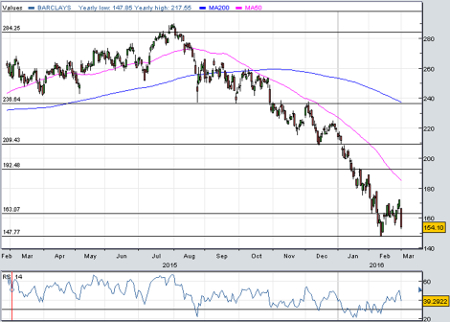Barclays sinks as dividend sliced
1st March 2016 13:38
by Lee Wild from interactive investor
Share on
Jes Staley knew hard decisions lay ahead when he took over at in December. Three months later and the American banker has put the African business up for sale and halved the dividend for the next two years. It sparked a rush for the exit Tuesday and Barclays shares plunged as much as 11%.
As tough as these decisions are, Staley has little choice. Too much capital is held in respect of its 62.3% stake in Barclays Africa, and regulatory requirements are onerous. A dividend giving a yield of over 4% is also excessive when profit misses targets by such a huge margin.
In the fourth quarter of 2015, Barclays made an underlying pre-tax profit of £607 million, a 33% miss versus consensus estimates for £909 million, according to Investec Securities. Include "transformation" and litigation costs and that drops to £247 million compared with City forecasts for £616 million.
And it gets worse. Add back a £1.45 billion provision for mis-selling payment protection insurance and Barclays lost £1.9 billion in the last three months of 2015, far more than expected. Running down non-core business lost £1.46 billion, while expensive Treasury operations and reform costs meant head office lost £402 million in the quarter.
For the full-year, pre-tax profit fell by 8% to less than £2.1 billion on total income up 1% at £26 billion. Profit actually rose by 3% at the core business to £6.86 billion.

The run-down of non-core assets will continue apace in 2016. Another £8 billion of so-called risk-weighted assets (RWAs) have been dumped in the "for sale" pile, mostly investment bank businesses, Southern European cards and Asian Wealth operations.
That will cost an extra £600 million to exit in 2016, although Barclays still thinks it can get total non-core RWAs down from £55 billion to £20 billion by the end of 2017. This does mean, however, that shareholders, who will receive 6.5p in dividends for 2015, will get just 3p both this year and next.
Elsewhere, an increase in the common equity tier 1 (CET1) ratio - a measure of financial strength - to 11.4% did, at least, beat expectations. And selling down the Barclays Africa stake over the next two-three years is tipped to improve CET1 by "at least" 100 basis points. A decision to simplify the bank into two divisions - UK retail and Corporate & International - makes good sense.
"While we believe that the cut in dividend will be taken negatively initially, it will help to allay fears of capital weakness and, with Barclays trading at a reported price/tangible book value [ratio] of 0.6, for core return on tangible equity of 10.9%, we continue to believe the shares are significantly undervalued," writes Shailesh Raikundlia at Haitong Securities.
Ian Gordon at Investec Securities agrees. While his forecasts and 245p price target are "under review", he still rates the shares a 'buy'. "Barclays is (on valuation) our preferred bank," he says.
This article is for information and discussion purposes only and does not form a recommendation to invest or otherwise. The value of an investment may fall. The investments referred to in this article may not be suitable for all investors, and if in doubt, an investor should seek advice from a qualified investment adviser.